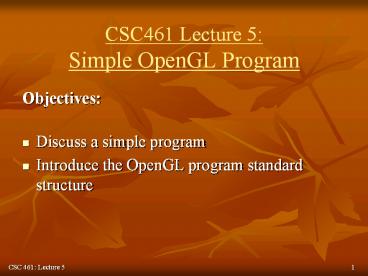CSC461 Lecture 5: Simple OpenGL Program - PowerPoint PPT Presentation
Title:
CSC461 Lecture 5: Simple OpenGL Program
Description:
There is only one set of transformation functions so we must set the matrix mode ... If the application is in two dimensions, we can use the function ... – PowerPoint PPT presentation
Number of Views:26
Avg rating:3.0/5.0
Title: CSC461 Lecture 5: Simple OpenGL Program
1
CSC461 Lecture 5Simple OpenGL Program
- Objectives
- Discuss a simple program
- Introduce the OpenGL program standard structure
2
A Simple Program
- Source code simple.c
- Generate a square on a solid background
include ltglut.hgt void mydisplay()
glClear(GL_COLOR_BUFFER_BIT) glBegin(GL_POLYGON
) glVertex2f(-0.5, -0.5)
glVertex2f(-0.5, 0.5)
glVertex2f(0.5, 0.5)
glVertex2f(0.5, -0.5) glEnd() glFlush()
// force to display int main(int argc, char
argv) glutCreateWindow("simple")
glutDisplayFunc(mydisplay)
glutMainLoop()
3
Event Loop
- Note that the program defines a display callback
function named mydisplay - Every glut program must have a display callback
- The display callback is executed whenever OpenGL
decides the display must be refreshed, for
example when the window is opened - The main function ends with the program entering
an event loop
4
Defaults
- simple.c is too simple
- Makes heavy use of state variable default values
for - Viewing
- Colors
- Window parameters
- Next version will make the defaults more explicit
5
Program Structure
- Most OpenGL programs have a similar structure
that consists of the following functions - main()
- defines the callback functions
- opens one or more windows with the required
properties - enters event loop (last executable statement)
- init() sets the state variables
- viewing
- Attributes
- callbacks
- Display function
- Input and window functions
6
Simple.c revisited
- In this version, we will see the same output but
have defined all the relevant state values
through function calls with the default values - In particular, we set
- Colors
- Viewing conditions
- Window properties
7
Source main.c
- include ltGL/glut.hgt
- int main(int argc, char argv)
- glutInit(argc,argv)
- glutInitDisplayMode(GLUT_SINGLEGLUT_RGB)
- glutInitWindowSize(500,500)
- glutInitWindowPosition(0,0)
- glutCreateWindow("simple")
- glutDisplayFunc(mydisplay)
- init()
- glutMainLoop()
8
Source code init.c
- void init()
- glClearColor (0.0, 0.0, 0.0, 1.0)
- glColor3f(1.0, 1.0, 1.0)
- glMatrixMode (GL_PROJECTION)
- glLoadIdentity ()
- glOrtho(-1.0, 1.0, -1.0, 1.0, -1.0, 1.0)
9
Source code mydisplay.c
- void mydisplay()
- glClear(GL_COLOR_BUFFER_BIT)
- glBegin(GL_POLYGON)
- glVertex2f(-0.5, -0.5)
- glVertex2f(-0.5, 0.5)
- glVertex2f(0.5, 0.5)
- glVertex2f(0.5, -0.5)
- glEnd()
- glFlush()
10
GLUT functions
- glutInit allows application to get command line
arguments and initializes system - gluInitDisplayMode requests properties of the
window (the rendering context) - RGB color
- Single buffering
- Properties logically ORed together
- glutWindowSize in pixels
- glutWindowPosition from top-left corner of
display - glutCreateWindow create window with title
simple - glutDisplayFunc display callback
- glutMainLoop enter infinite event loop
11
Coordinate Systems
- The units in glVertex are determined by the
application and are called world or problem
coordinates - The viewing specifications are also in world
coordinates and it is the size of the viewing
volume that determines what will appear in the
image - Internally, OpenGL will convert to camera
coordinates and later to screen coordinates
12
OpenGL Camera
- OpenGL places a camera at the origin pointing in
the negative z direction - The default viewing volume
- is a box centered at the origin with a side of
length 2
13
Orthographic Viewing
In the default orthographic view, points are
projected forward along the z axis onto the plane
z0
14
Transformations and Viewing
- In OpenGL, the projection is carried out by a
projection matrix (transformation) - There is only one set of transformation functions
so we must set the matrix mode first - glMatrixMode(GL_PROJECTION)
- Transformation functions are incremental so we
start with an identity matrix and alter it with a
projection matrix that gives the view volume - glLoadIdentity()
- glOrtho(-1.0, 1.0, -1.0, 1.0, -1.0, 1.0)
15
Three-dimensional viewing
- glOrtho(left,right,bottom,top,near,far)
- Left, right, bottom, top, near and far specify
the six sides - The near and far distances are measured from the
camera
16
Two-dimensional viewing
- Two-dimensional vertex commands place all
vertices in the plane z0 - If the application is in two dimensions, we can
use the function - gluOrtho2D(left, right,bottom,top)
- In two dimensions, the view or clipping volume
becomes a clipping window































